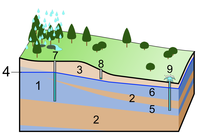
Photo from wikipedia
Water plays an important role in the mechanical properties of roadway surrounding rocks and poses a great threat to their stability. To study the damage and failure characteristics, and the… Click to show full abstract
Water plays an important role in the mechanical properties of roadway surrounding rocks and poses a great threat to their stability. To study the damage and failure characteristics, and the fracture development laws of surrounding rock, a uniaxial compression test for prefabricated fractures in water-bearing surrounding rock was carried out. Results indicate that water-bearing prefabricated fracture specimens are in better development condition after failure. In water-bearing specimens, the propagation direction is more complex. There are more secondary fissures, and the fracture strength is significantly lower than in dry specimens. When immersed in water, the interior structure of surrounding rock is weakened and softened; thus, the intensity is reduced, and the development and propagation of fractures is promoted. For larger angles of the prefabricated fractures, the compression failure of surrounding rock changes into shear failure. As the angles approach 90°, the shear failure again prevails. Therefore, the strength of the surrounding rock firstly decreases and then increases. A new ultimate stress strength model is developed for fractures caused by shear slip failure in water-bearing surrounding rock. The model results are consistent with the experimental results, and the validity of the model is verified. These results are helpful for deeply understanding the failure process of water-bearing surrounding rock with prefabricated fractures. The proposed model could be used for the evaluation of water-bearing surrounding rock stability in coal mines, as well as dynamic risk monitoring.
Journal Title: Environmental Earth Sciences
Year Published: 2018
Link to full text (if available)
Share on Social Media: Sign Up to like & get
recommendations!